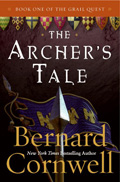


Note: This trilogy contains books #14, #15, and #16 in my 52 Books in 52 Weeks challenge for 2008.
This series by Bernard Cornwell consists of three books: The Archer’s Tale, Vagabond, and Heretic. I’m just gonna lump them all together here since there’s really not a whole lot to set them apart. By that I mean that they’ve definitely got the trademarks of an overly prolific author who just churns stuff out within his comfort zone (e.g., I got tired of hearing about how an arrow head “pierced mail and leather” after the fifth time in one book) so that you get largely the same story being told 3 times, with slight variations and a big payoff at the end. So it makes sense to consider them all at once, because otherwise I’d just end up repeating myself. A lot like the author.
But actually, I kind of enjoyed these books despite how they felt stretched out and meandering. They tell the story of Thomas of Hookton, an English archer during the middle ages who is searching for the Holy Grail. The Grail-with-a-capital-G is, as you may know, supposedly the cup from which Christ drank at the last supper and which caught the blood from His side as He hung on the cross. The Grail Quest books are, as you might further surmise from this short description, works of historical fiction set towards the end of the middle ages. In a way, the books read a lot like fantasy except that all the fantasy staples that makes me groan and roll my eyes every other page are have blessedly gone missing. You’ve still got big beefy guys in armor who scream battle cries as they storm castles, trample the country side, and generally hack the living daylights out of each other, but you don’t have tired stuff like wizards, elves, prophecies, magic, political intrigue, and whatever other junk most fantasy authors like to fish out of the recycling bin. It was oddly refreshing, even if it’s only because I’ve not read much historical fiction before.
It’s also a lot of what I would call “military pr0n” of the medieval variety. One of Cromwell’s hallmarks seems to be that he takes an imaginary character (such as the aforementioned Thomas of Hookton) and slips him in to real historical events, like this battle or that siege or that some other big event that generally takes a name according to the “The Verb of Location” standard. Cromwell then goes to great, delightful lengths to describe the tactics and strategies that each side used, steeping the whole thing in human drama from a soldier’s point of view. At times it read a bit like the instruction manual to a real-time strategy game like Age of Empires with detailed explanations about how the English placed their pike men along a low ridge that gave them an attack bonus against mounted infantry that stacked with their terrain bonuses AND faction attributes. Well, maybe it wasn’t that blatant, but I still dig that kind of thing. And casting the main character in the role of an English Archer with his big ole longbow (though, oddly, it was never called by that name) gave him a good excuse to teach us all about archery and the overwhelmingly effective use of such archers in warfare. Fun stuff.
But even if there was a history-cum-videogame abstraction to the battles at times, I was nonetheless struck by how incredibly savage and harsh warfare apparently was in those days. Cornwell didn’t shy away from vivid descriptions of bloody hand-to-hand fighting and brutal tactics that don’t much resemble the romanticized image of a chivalrous knight of the Round Table. I was also forced to admit that Cornwell writes some of the best insults I’ve ever seen. When one side accuses the other of being “turds birthed from Satan’s own arse” that’s the kind of curse that you just gotta sit up and admire.
What about the story? Well, it’s nothing too fantastic, mainly following Thomas around as he follows the trail of the Holy Grail while being pursued by his villainous cousin. Well, when he’s not busy being an archer, bedding wenches (he goes through three love interests in a very James Bond-esque fashion in the course of the trilogy), laying siege to castles, and getting tortured by the Spanish Inquisition (which, by the way, everybody expected as soon as the first Dominican priest was introduced, contrary to what any flying circus tells you). But while his path is circuitous, this is the quest that ties all the books together, and it’s resolved nicely at the end so that I was left with a satisfied feeling that I had seen something that was entertaining and a bit educational, but not necessarily full of itself.
Others doing the 52-in-52 thing this week:
- Jeremy reviews The Moment It Clicks
- Heliologue reviews A History of God by Karen Armstrong, Eldest by Christopher Paolini, Saint Francis of Assisi by G.K. Chesterton
- Natasha reviews Elija of Buxton by Christopher Paul Curtis, Fablehaven by Brandon Mull, and Bee Season by Myla Goldberg
I had considered reading these, but I think I’ve seen enough to dissuade me. Thanks for the heads up. I’ll read something better, instead.
Eh, yeah there’s probably better stuff out there to read, but as I said I kind of enjoyed these. Not sure I’m going to run out and read the other five thousand similar books Cornwell has apparently written, but these were decent enough entertainment.
I don’t mind books in a series being similar, but when it starts to feel like they’ve been written ny assembly line I get turned off.